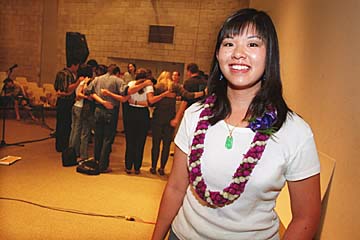


Young stroke
victim, at death’s
door, rebounds
Stricken at 18, Corrie Wong
By Lori Tighe
lived, walked and earned a
degree in speech from UH
Star-BulletinCorrie Wong's stroke at age 18 was so massive, her doctor prepared her family for her death. She lived. The damage was so great, her recovery team said she would never walk again. She walked -- and kept right on going.
But even her family and closest supporters never thought she would graduate from the University of Hawaii with a bachelor's degree in speech pathology, to help others overcome "the impossible."
"Corrie had every right to be angry at the world, but she went on and did a great thing," said her cousin, Julie Okamura, 33, one of the major players in Wong's recovery. "I'm so inspired by her."
Wong, who lives in Honolulu, had started having numbness in her left hand and lots of headaches during her junior year at Punahou School. Her doctor, who couldn't find anything wrong, blamed it on stress.
"I knew in my heart it wasn't that, but I didn't get a second opinion," Wong said.
She enrolled at the University of Hawaii, and in her first month experienced symptoms that lasted 24 hours. She repeatedly dropped her keys and couldn't grip the steering wheel of her car.
"I had no feeling," she recalled. Her doctor suspected a pinched nerve and sent her to a chiropractor. But when her walking began to fail, a neurologist put her in Queen's Hospital for tests in September 1993.

There she had a series of strokes that paralyzed her entire left side."I was out of it," Wong said. "All I remember is waking up and and almost falling out of bed. My left side was so weak."
After giving her a magnetic resonance imaging scan, her doctor diagnosed her with a disease called Moya-moya, a rare congenital disorder found in people of Japanese ancestry that prevents full development of major blood vessels going to the brain. Instead of the blood flowing through her carotid arteries, it was flowing through capillaries the size of hair strands.
"The doctor told us she may die. It was hard to take," said her father, Art Wong. "If she lived, we wondered if she would have brain damage or if she would walk again. The scariest thing: The doctors said it could happen again."
Wong's recovery team at Rehabilitation Hospital of the Pacific set her goal as a "household wheelchair user" because of her massive stroke damage.
Wong lost vision in her left eye, had slurred speech and couldn't lift her head.
Although her long-term memory seemed intact, her attention span diminished greatly.
Okamura, who also worked as a physical therapist at Rehabilitation Hospital, believed Wong could go beyond a wheelchair. For about three months, Okamura worked with Wong nightly, after her full days of therapy.
"Part of it was emotional. Here's my cousin whom I've known since she was born," Okamura said. "I thought she would walk again, but I never thought she would go as far as she has."
Okamura helped Wong use weight training exercises to strengthen her torso. It needed toughening so that her arm and leg would work.
"You can't control what comes back. You hope other parts of the brain take over. By getting her to move muscles, she gives input back to the brain for normal functioning," Okamura said.
Wong seemed motivated, positive, and rarely felt sorry for herself, Okamura said. Faith in God and family support helped Wong keep going.
Her parents researched Moya-moya and found a specialist in San Francisco who performed brain surgery on others with the rare disease. By the time Wong arrived in San Francisco for surgery in November 1993, she was walking with a cane.
Dr. Michael Edwards opened her cranium and rerouted her capillaries to other parts of the brain, hoping they would reattach and grow. The operation was successful.
She returned to Honolulu and continued with physical therapy.
"The whole thing is to have a goal -- my goal was to return to school," Wong said. During her recovery, she had admired her speech therapist and decided to pursue the field as her new career.
She began with a few courses to build up her stamina.
"I had to work with her," said her father. "She came home and cried every day. She couldn't handle the material. In a geography class, studying the Mediterranean, she had a hard time remembering where Italy and Spain were."
She eventually built up her stamina and increased her class load to full time.
The Kokua program, which helps physically challenged students, enabled Wong to work longer on tests, and in a private room. Volunteers helped her take notes. Now she volunteers for the Kokua program, helping others.
She now walks with a brace around her left ankle, which remains paralyzed, as is most of her left arm.
"I'm basically one-handed. I dress myself, wash myself, cook with one hand. I can do most anything. It's OK I'm different," said Wong, who plans to get her driver's license soon.
She goes on to graduate school in speech pathology in the fall at UH, and may decide to work with kids.
This summer, her first one off in five years, she will volunteer for two weeks at a Romanian orphanage with Project HOPE.
"I'm just grateful to God. Without the support, I never would have made it," she said. "He brought me such a long way."